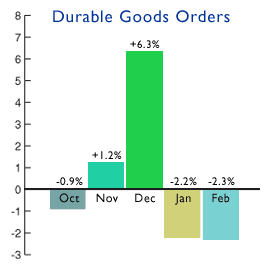|
Durable orders drop again
|
 |
March 24, 2000: 8:51 a.m. ET
February orders decline 2.3%, more than expected; ex-transport down 0.2%
|
NEW YORK (CNNfn) - Orders for durable goods from U.S. factories declined for the second time in five months in February, the government reported Friday, a slower pace than forecast, suggesting that pockets of the economy may be starting to feel the effects of higher interest rates.
 Orders for long-lasting goods such as refrigerators and dishwashers fell 2.3 percent in February, against the flat reading expected by analysts and steeper than the revised 2.2 percent drop registered in January. Excluding transportation products, which tend to be volatile from month to month, orders slipped 0.2 percent after a drop of 0.5 percent a month earlier. Orders for long-lasting goods such as refrigerators and dishwashers fell 2.3 percent in February, against the flat reading expected by analysts and steeper than the revised 2.2 percent drop registered in January. Excluding transportation products, which tend to be volatile from month to month, orders slipped 0.2 percent after a drop of 0.5 percent a month earlier.
The monthly drop in orders was the largest since April 1999, when orders slipped 2.4 percent. Although considered volatile, some analysts took the decline as a sign that the robust U.S. economy may be showing some signs of slowing, at least in some areas of the manufacturing sector.
"These numbers really indicate some pockets of weakness," Lynn Reaser, chief economist with Bank of America Asset Management, told CNNfn's Before Hours. "It suggests manufacturers are having a difficult time in some sectors and it does suggest some areas of slowing within the economy."
Machinery orders drop
Orders for industrial machinery and transportation equipment led the declines. Industrial machinery orders fell 4.6 percent while orders for transportation products fell 8.7 percent. Electronic goods partially offset the declines, posting a gain of 6.4 percent on the month.
 While the report is not considered one of the most scrutinized numbers by Fed Chairman Alan Greenspan, Reaser suggested the numbers could convince Fed policy makers that the economy is beginning to feel the effects of its rate increases, the most recent coming this past Tuesday in the form of another quarter-point rise. (522KB WAV) (522KB AIFF) While the report is not considered one of the most scrutinized numbers by Fed Chairman Alan Greenspan, Reaser suggested the numbers could convince Fed policy makers that the economy is beginning to feel the effects of its rate increases, the most recent coming this past Tuesday in the form of another quarter-point rise. (522KB WAV) (522KB AIFF)
At the same time, Reaser and other analysts pointed out that other areas of the economy, particularly service-related industries, continue to drive growth well beyond what most consider to be a normal, non-inflationary pace. The U.S. economy expanded at a 6.9 percent pace in the fourth quarter, and is expected to post 5-percent-plus growth in the first quarter of 2000.
"Despite the weakness of the past two months, the general underlying trend for the economy is still higher," said Rob Palombi, a senior markets analyst with Standard & Poor's MMS in Toronto. "The data still point to strength in the manufacturing sector, and upcoming orders appear strong."
Demand still there
Indeed, unfilled orders -- orders that have been received but not yet shipped -- rose 0.5 percent in February after a 0.7 percent increase in January, suggesting factories will continue to churn out goods in the months ahead.
 U.S. factories have been stepping up production in response to surging consumer demand, an enormous factor behind the resilient economy that the Fed is trying to tame. Consumer spending accounts for roughly two-thirds of the economy's output; personal spending rose at a 5.9 percent annual pace in the fourth quarter, according to the Commerce Department. U.S. factories have been stepping up production in response to surging consumer demand, an enormous factor behind the resilient economy that the Fed is trying to tame. Consumer spending accounts for roughly two-thirds of the economy's output; personal spending rose at a 5.9 percent annual pace in the fourth quarter, according to the Commerce Department.
Orders for non-defense durable goods, a category that excludes what factories churn out for the U.S. Army and other defense-related vendors, fell 2.4 percent in February after a 1.3 percent January decline. Orders for non-defense capital goods excluding aircraft, a measure of business spending on new equipment, fell 7.5 percent in February.
Shipments of durable goods declined 1.8 percent in February after a 1.5 percent January rise. Shipments of non-defense goods outside of aircraft, which influences the gross domestic product report, fell 2.9 percent last month after a 5.9 percent increase. 
|
|
|
|
|
 |

|

